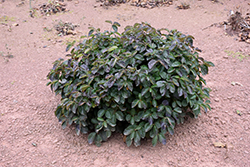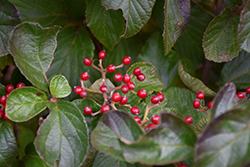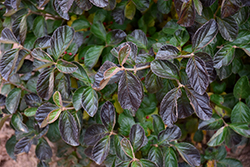It's all about ...
plants

C.A. Hildebrant's Viburnum
Viburnum wrightii 'C.A. Hildebrant's'
Height: 8 feet
Spread: 8 feet
Sunlight:
![]()
![]()
Hardiness Zone: 6a
Description:
A wonderful dense, rounded shrub, with showy clusters of snowy white flowers in spring followed by brilliant red fruit, and good fall color; hardy and adaptable; makes a great specimen or mixed shrub border addition
Ornamental Features
C.A. Hildebrant's Viburnum is blanketed in stunning creamy white lacecap flowers held atop the branches in mid spring. The scarlet fruits are held in abundance in spectacular clusters from late summer to late winter. It has dark green deciduous foliage which emerges deep purple in spring. The large glossy oval leaves turn outstanding shades of gold, red and burgundy in the fall. The smooth gray bark and tan branches add an interesting dimension to the landscape.
Landscape Attributes
C.A. Hildebrant's Viburnum is a multi-stemmed deciduous shrub with an upright spreading habit of growth. Its relatively coarse texture can be used to stand it apart from other landscape plants with finer foliage.
This is a relatively low maintenance shrub, and should only be pruned after flowering to avoid removing any of the current season's flowers. It is a good choice for attracting birds to your yard, but is not particularly attractive to deer who tend to leave it alone in favor of tastier treats. It has no significant negative characteristics.
C.A. Hildebrant's Viburnum is recommended for the following landscape applications;
- Accent
- Mass Planting
- Hedges/Screening
- General Garden Use
Planting & Growing
C.A. Hildebrant's Viburnum will grow to be about 8 feet tall at maturity, with a spread of 8 feet. It tends to be a little leggy, with a typical clearance of 1 foot from the ground, and is suitable for planting under power lines. It grows at a medium rate, and under ideal conditions can be expected to live for 40 years or more. This variety requires a different selection of the same species growing nearby in order to set fruit.
This shrub does best in full sun to partial shade. It prefers to grow in average to moist conditions, and shouldn't be allowed to dry out. It is not particular as to soil type or pH. It is highly tolerant of urban pollution and will even thrive in inner city environments. This is a selected variety of a species not originally from North America.
This plant is not reliably hardy in our region, and certain restrictions may apply; contact the store for more information.


